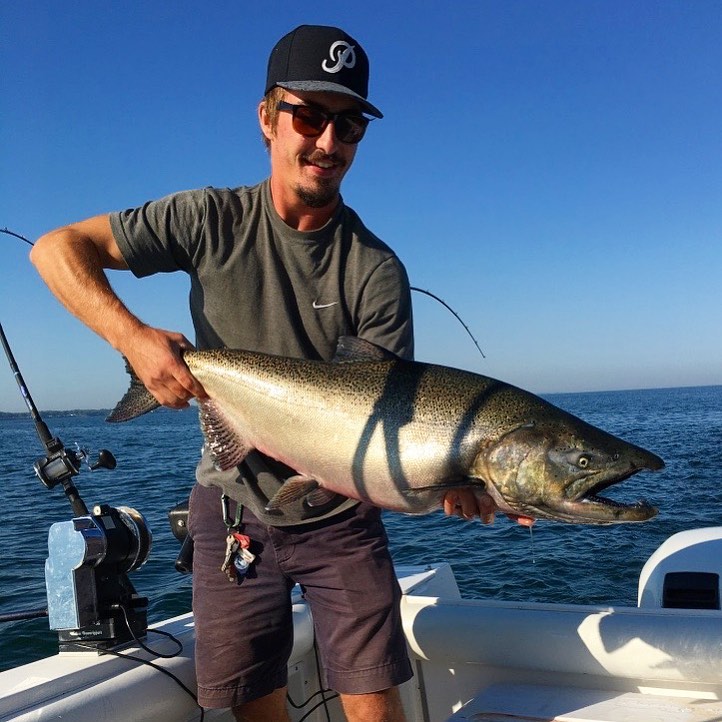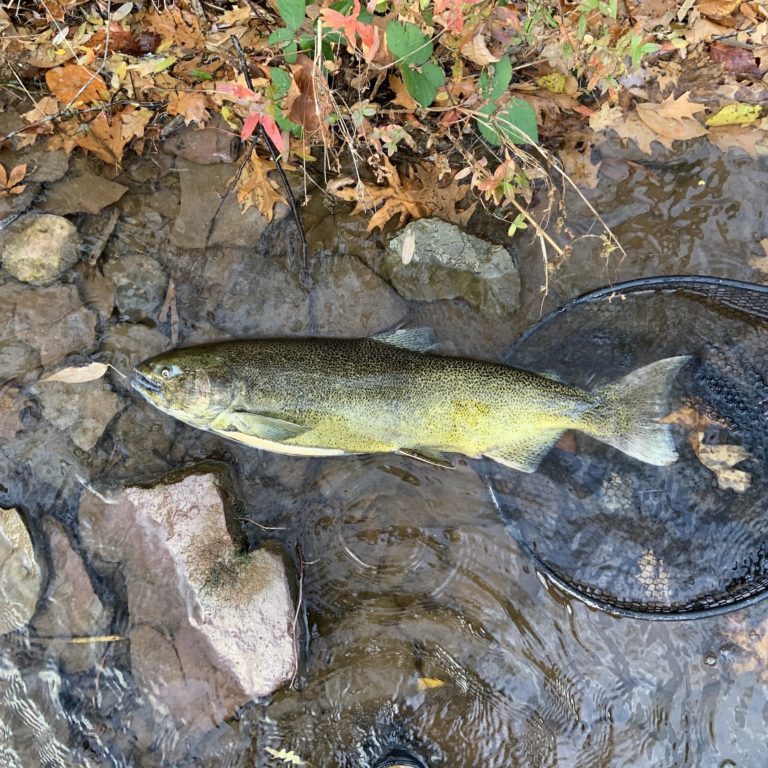The Chinook Salmon

The Chinook salmon (Oncorhynchus tshawytscha), also known as king salmon, is a cold-water sport fish found primarily in Lake Ontario and its tributaries. Chinook salmon are rare in Lake Erie. Chinook salmon typically range between 24 and 36 inches in length and can vary quite a bit in appearance. When residing in Lake Ontario or Erie, Chinook salmon usually have a silver belly and sides, a dark green/gray back, black spots speckling the upper back area, and usually a dark gray face and head (see the first picture). When Chinook salmon run up creeks and rivers in the fall, their coloration tends to become darker (see the second picture). Spawning Chinook salmon in creeks and rivers usually have a dark colored, green/gray to deep olive body.
Chinook salmon are one of many anadromous salmonids found in western New York and are a hugely popular sportfish. Chinook salmon can be distinguished from steelhead and Coho salmon by the color of their mouths, which are completely black. Coho salmon and steelhead have white gums. Chinook salmon are the largest of the salmonids (based on official reports).
Habitat
Chinook salmon are anadromous fish, meaning they reside in a large body of water before swimming up creeks and rivers to spawn. Chinook salmon will live in the deep waters of Lake Ontario or Erie for most of their lives. Once they reach sexual maturity, Chinook salmon swim up creeks and rivers where they spawn. During the spawn, Chinook salmon typically reside in deep pools and runs in creeks and rivers. Chinook salmon also like the well oxygenated water beneath waterfalls. Chinook salmon die after spawning.
Lake Ontario is especially conducive to sustaining salmon populations because of its depth. Lake Ontario has a maximum depth of 801 feet and can therefore maintain the cold water temperatures needed for salmon survival year round. In Lake Ontario, Chinook salmon cruise the water column, typically at depths below 80 feed, feeding on baitfish.
Food
When residing in Lake Ontario, Chinook salmon feed on baitfish. The plentiful supply of baitfish in Lake Ontario allows Chinook salmon to reach great sizes in only a few years. Once they enter creeks and rivers, Chinook salmon do not feed because they are focused on spawning. However, a Chinook salmon’s natural instinct will cause it to bite eggs or baitfish that venture too close.
Where to Catch Chinook Salmon
Lake Ontario maintains an excellent population of Chinook salmon as they are stocked extensively in Lake Ontario tributaries. Therefore, the most popular place to target Chinook salmon is the Niagara Frontier including Niagara and Orleans Counties. Chinook salmon are also present but rare in Lake Erie.
In the summer, Chinook salmon reside in Lake Ontario or Erie and cannot be caught in tributaries. The best way to target Chinook salmon in the summer is by trolling in deep water with a boat. The only exception to this is rare occasions when upwelling occurs near the Lake Ontario shores. When upwelling occurs and colder water is pushed up from the deep, salmon and trout can become confused and enter the mouths of Ontario tributaries. These events can occur in July or August and are short lived.
The only time to target Chinook salmon without a boat is during the run. The salmon run usually begins in September and peaks in October. During the run, Chinook salmon can be caught in most Lake Ontario tributaries. The most popular Lake Ontario tributaries are 18 Mile Creek and The Oak Orchard River. When fishing these streams, you will not be alone. During the height of the salmon run, anglers seem to outnumber the fish!

How to Catch Chinook Salmon
Fly-fishing is one popular method for targeting Chinook salmon in creeks and rivers. Productive baits for Chinook salmon include egg patterns and streamers. It is usually best to fish egg patterns under an indicator with split shot weight added about 1 foot from the hook. Enough split shot should be added so that your weight reaches and drags on the bottom of the stream. You should aim to drift your fly as close to the fish’s mouth as possible.
Swinging streamers is another good option. From personal experience, king salmon seem to respond particularly well to olive colored streamers. Although Chinook salmon are not feeding during the spawn, swinging streamers close to Chinook salmon will often trigger reaction strikes. Keep in mind that it may take several drifts before the fish takes, if it does at all.
Spin fishing is another way to target Chinook salmon during the run. Contrary to the belief of many, salmon WILL strike bait during the run. Snagging is NOT the only way to catch salmon and is ILLEGAL. Productive baits for the spin fisherman include egg sacs, trout beads, spinners, and jigs. Fishing egg sacs under a float is especially popular amongst salmon anglers on Lake Ontario tributaries.
There is some good information regarding salmon fishing in western New York on the NYS DEC website including public fishing access maps: http://www.dec.ny.gov/outdoor/62216.html
